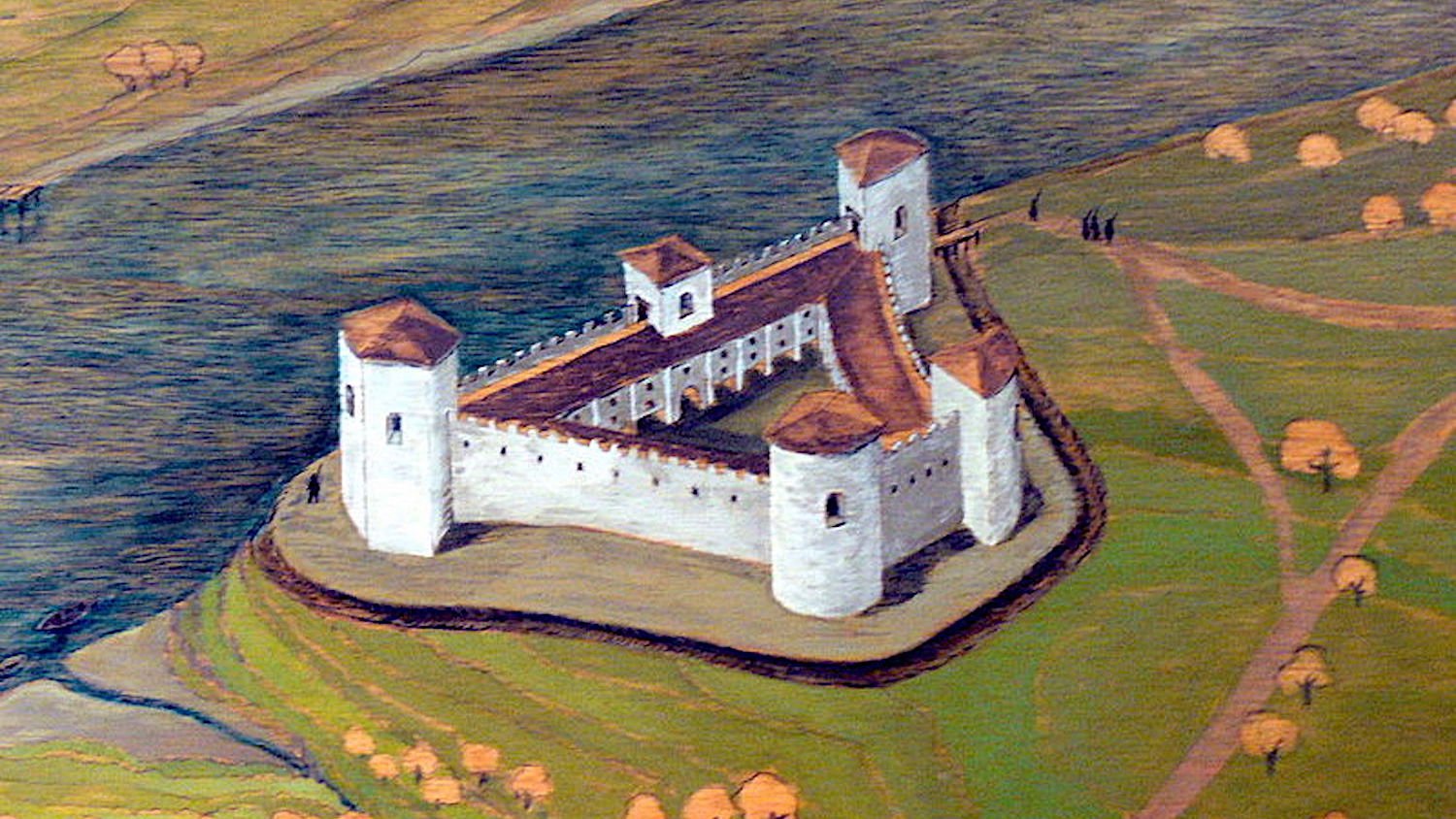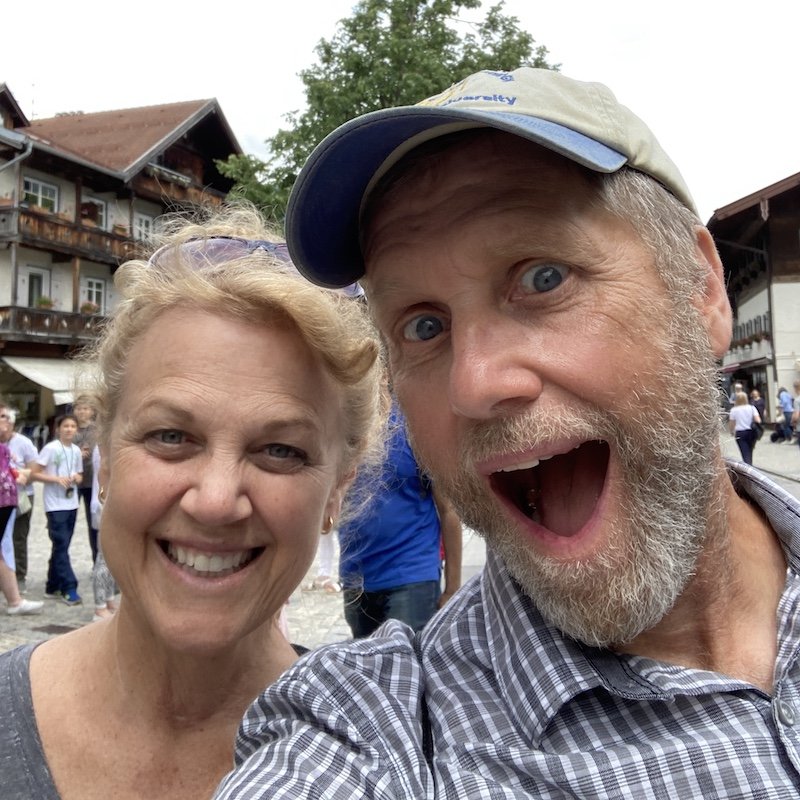We glided into Passau, Germany, the city of three rivers, the Dreiflüssestadt. It was raining but we were not damp.
I did my homework and sorted through the ship’s planned excursions. While each was interesting in its own way, I had a different target in mind: Das Römermuseum Kastell Boiotro. I asked Jelena, the tall cruise manager who stood even taller in her red high heels. She didn’t know about a Roman museum in Passau. She looked it up on her iPhone.
The museum was located on the bank of the Inn River, on the far side of Passau’s “Old City.”
“I don’t think it will be open when you get there,” she said, shaking her head.
Modern Passsau is located at the junction of three rivers: the Danube (or Donau) is joined by the Inn from the north and the Ilz from the north. This place was strategic and heavily fortified in the Roman period. Roman-era findspots marked by circles. Image from signage in the Römermuseum.
Undaunted, Vicki and I pulled on our raincoats and walking shoes. We disembarked via the top deck. Vicki brought an umbrella from our cabin. It was marked by the company “AmaWaterways.” The sky was spitting.
We stopped at the first open shop and asked for directions. The woman wasn’t so sure and pulled out her iPhone.
“Ah,” she said with a heavy accent. “Go down the street. Turn right at city hall. Go over the hill.” Then she made a series of moves with her hand. “Turn left, right, left.” She stopped midway in the journey, sensing the futility of it. “Then . . . ask someone else.” She laughed.
“Danke schön," we chirped.
“Tschüss,” she sang back.
A bridge crossing the Danube (Donau) River.
We found the City Hall as she said. Inside we got a paper map of the city. Using it, we crossed over the hill, and after a series of turns on narrow cobblestone streets, arrived on the bank of another river, the Inn. It was nearly the same size as the Danube.
“Now we need a bridge.”
The bridge shortly presented itself and in less than a kilometer we found ourselves in front of the Das Römermuseum Kastell Boiotro. It was located in a late medieval house, painted a salmon color. The museum was open for another hour.
The gate was open.
Inside, we discovered the foundations of Roman fort, built in the late third century AD. It was a part of a larger network of defensive positions at the junction of the three rivers. These structures, in turn, were a part of the forward line of military camps known collectively as the Roman limes. This line was occupied by irregulars, often locals, who enforced the policies of the Empire in exchange for a good salary, housing, and, hopefully, citizenship.*
Vicki and I wandered through the small museum grounds, photographing the fort foundations, imagining its situation (“modern” construction now blocks a view to the river), and deciphering the signage.
Vicki standing near a corner tower of Fort Boiotro.
Inside we found even more surprises. The museum was excellent in every way: organized, informative, well-labeled, and staffed by a friendly fellow who was the only other living soul on the property.
As a plus, artifacts on display not only presented interpretations of the fort, but other (and earlier) aspects of Roman settlement in Passau as well as prehistoric finds (Late Stone and Iron Ages) in the vicinity. It was splendid. I even bought the book.
An artist’s reconstruction of the Roman fort along the River Inn in modern Passau, Germany. The fort had an irregular trapezoidal shape and was surrounded by a moat.
I was fascinated by a bronze plate with a man’s name chiseled in it. He had completed his 25-year commitment to the Roman Army and had received the plate as a “diploma.” In addition to his pay and housing for his service, he and his family were granted citizenship in the Empire. Not bad for someone who was likely a “barbarian.”
It caused me to reflect on a passage in the book of Acts where the Apostle Paul stood before a Roman officer (chiliarchos). The officer claimed he paid a great sum of money for his citizenship (politeia). The Apostle countered, “I was born a citizen” (22:28). Such citizen privileges were highly valued in the New Testament era and in the centuries that followed.**
The sky was still spitting as we made our way back to the ship. We were wet and tired but grateful that we found Das Römermuseum Kastell Boiotro.
The location of Fort Boiotro. The Danube marked the northern limit of the empire.
*These irregulars were paid less that legionnaires, but if they fulfilled a 25-year service career, they could earn their citizenship. Jörg-Peter Niemeier, Passau-Teil des Römischen Reiches (Passau, 2014: 68).
**If you are interested in learning more about Roman citizenship on the northern boundary of the empire, see the popularly-written article by Douglas Boin, “An Empire of Immigrants,” in Lapham’s Quarterly (June 15, 2020). You may find the article here: https://www.laphamsquarterly.org/roundtable/empire-immigrants.
We are having a relaxing time river cruising on the Danube. We are traveling from Vilshofen, Germany to Budapest, Hungary. Bus rides to Salzburg, walking adventures in Passau, bicycling in Vienna and other excursions fill in our days on the water. If this sounds like the kind of trip that you would be interested in, contact me at BibleLandExplorer@gmail.com.







